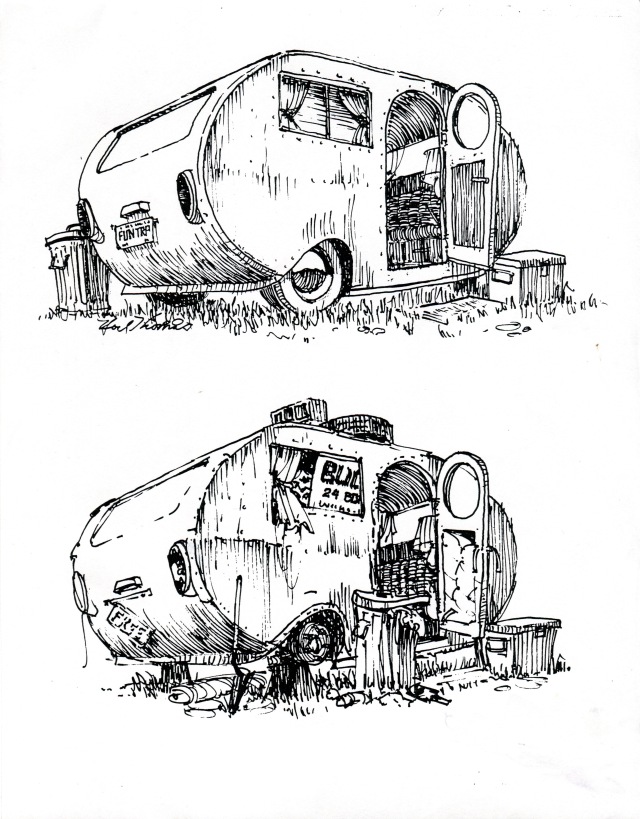
Aero II miniature Travel Trailer initial sketches
Ever the car nut, and ever the headline writer, Noel came up with the line, “You can go where you want with it,” while conjuring the travel traveler. It would be, of all the buildings we made, his pet project. Where he really wanted it to go was downhill to a derelict trailer park with one tire jacked up on a stump, but I, as acting CFO, won him over to the idea that we would more likely fill a class with the non-beater version of what was already an unconventional class project.

Aero II Travel Trailer, by Noel & Pat Thomas, 2003 (yes, it’s a miniature)
Early trailer folk were a jovial bunch—they dubbed themselves Tin Can Tourists. Our round-ended, flat-sided design they called the canned ham, not to be confused with the bread loaf, teardrop, or classic Airstream shapes. These aerodynamic designs were a combination of the talents of car designers, and, after World War II, airplane manufacturers.

The body design and warm wood interior stemmed from longtime Seaview neighbors Joe and Nita’s aluminum trailer, where they unwound on summer weekends after driving in from Portland. When they weren’t out fishing, or sacking the local Bingo parlor, they sat inside at the fold-out table smoking Kools and playing endless hands of poker. Late into the night we would hear them slapping down their cards and cackling.
As you can see below, construction of the body was labor intensive, requiring a lot of bending, taping, pinning, and time waiting for glue to dry.
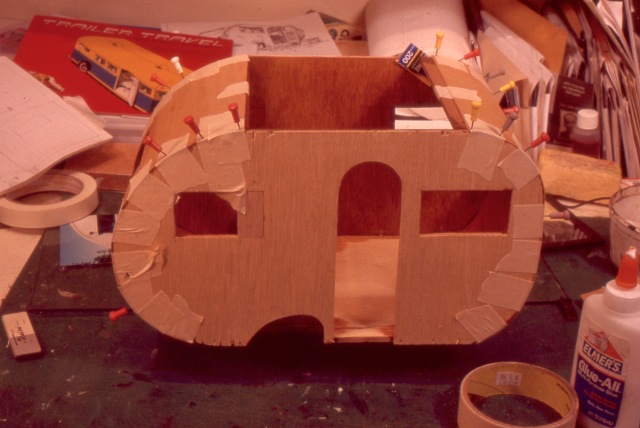
The shell consists of 1/4″ mahogany plywood sides with fir veneer end pieces
You can see that the size of the left window hole was modified when we realized we needed closet space inside.
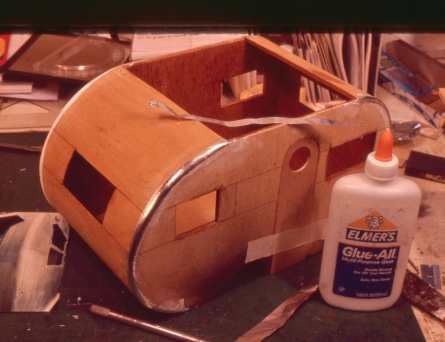
Aluminum car detailing tape covers the seams

Old aluminum printing plate is cut to cover the shell
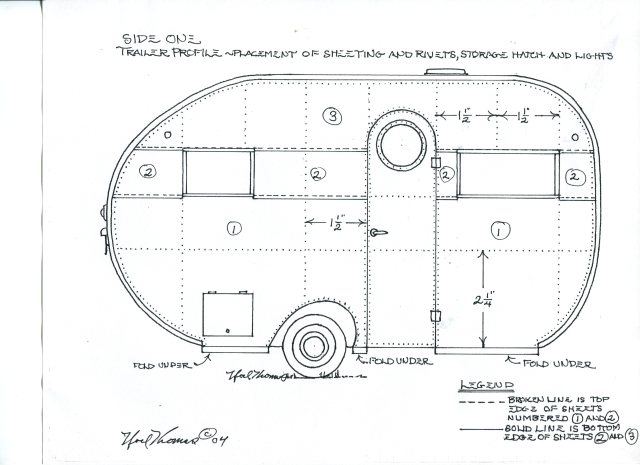
Class diagram for cutting and placing aluminum siding.
As always there were big questions about sources and supplies–things like exterior lights, wheels and tires, window glass, etc., but by this time (project #60) we had winged it so many times we didn’t lose much sleep over them–we knew, trusted, prayed that the lights would go on when needed.
The exterior tail and running lights gave us yet another excuse to visit New York, this time in search of rhinestones from one of the buttons & trims emporiums in the Garment District. To make the most of our short trip, we walked up Sixth Ave. from Greenwich Village to Herald Square so we could savor at ground level the mix of people, buildings, traffic–the sounds, smells and sights of the city we once inhabited. The District offered an array of businesses dealing in notions, but we chose, according to the card I saved, Metropolitan Impex, a bridal supply shop. Maybe it was the Pepto-pink exterior that called us in. The interior was a mammoth shoebox of a room whose walls were upholstered, floor-to-ceiling, with columns of little drawers, each containing some sort of button, beading, ribbon, or rhinestone. The quintessentially imperious shopkeeper didn’t bat an eyelash when we told her what we were looking for, and why (she wasn’t really interested in “why”)—she sailed toward the back of the shop and up a 12’ ladder to pull out boxes A, B, and C, for our approval. All she had needed was a ballpark measurement to hit it right, the first time.
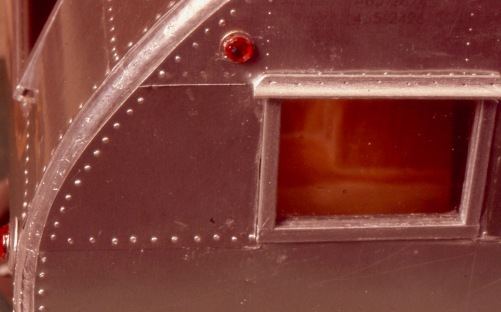
Exterior lights: 2 each red and amber 3/16 flat-backed rhinestones for the side running lights, and 2 ¼” reds for the tail lights. The running lights were backed with thin mini washers or aluminum punch-outs, plus the domed backing of ½” Dritz covered button refills from Joanne. The window “glass” we cut from thin plexiglass sold by US Plastics.
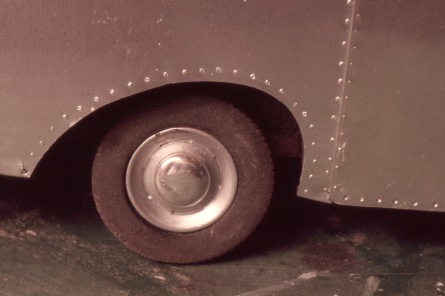
For the tires and wheels we fudged a bit on scale, sacrificing precision for looks, using smaller, diecast model car tires to get the right balloon look with half moon hubcaps. Noel found the first car, somewhere, for the prototype, but down the road, finding enough for thirty students took some real ingenuity. It turns out the wheel manufacturers wouldn’t sell to us, so we had to resort to buying a new model car for every two students. Luckily our wonderful local Deals Only overstock store just happened to have truckloads of trucks with tires that suited the project.
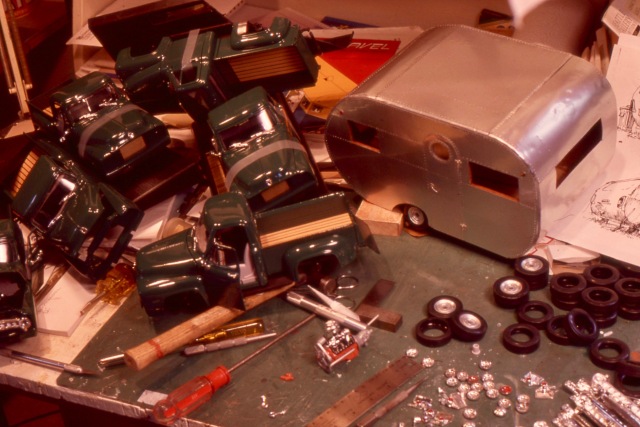
Spare parts pile
Details like the aging trailer hitch prompted a trip back to our old neighborhood in Seaview to inspect the one-time neighbors’ trailer. Not much was left of the original mechanism, but enough to give Noel a start. 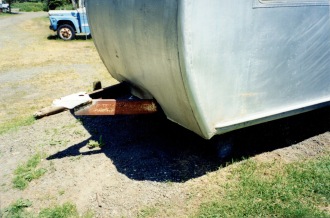
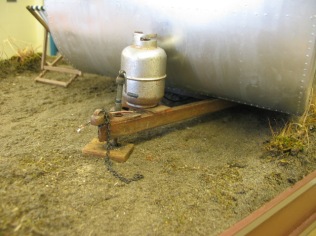
Ours (to the right) included the propane tank and saftey chain for when it was in tow.
That little touch of realism required our students to assemble 1/8 X 5/16″ basswood channel, a carved wooden knob, a brass finding, wire for the crank handle, a traingular basswod brace, a trapezoidal basswood brace, socket head cap screws, a grommet, chain, wood for hitch to rest on, thread for the electrical hookup to the tow vehicle tail lights.
A lot of work, maybe, but hey, we’re miniaturists, and detail is everything!
The trailer hitch has a terrific story to go with it, submitted by Janice Pattrson, one of our students: Pop was an oil field welder, which required him to be away in isolated places (for eleven years he never took even one day off). So he bought our trailer second-hand, and took us along every weekend, holiday, and summer vacation. It really was our little home on wheels—never a “recreational” vehicle. It was made of plywood, and painted two shades of green. I can still remember the sound of a hail storm in Saskatchewan (on the bald prairie). I was 8 years old, and I remember Mom reciting “The Walrus and the Carpenter,” trying to distract us from the storm. My parents remember it being called a “teardrop” trailer.
My other memories are of sitting for hours in the hot sun (again on the open prairie) while waiting for Pop to hitchhike to the nearest town for metal to repair the broken trailer hitch—we were grateful he could weld, because this happened fairly often. I hope our mini has a trailer hitch—if so I’ll age mine realistically by ripping half of it off and laying mini welding rods around it. Need a few gophers, too!
Last, but not least, access to the interior is gained by lifting out a roof panel:

The overhead cupboards, drawers and closet are made from 1/16″ basswood, stained a light oak. The counter and tabletop are basswood, covered with sponge-painted craft paper.
Noel carved the sink, stove and fridge unit from gelutong wood, finished with multiple layers of car primer and paint. The sink spigot was from Vix, that last I heard was bought by Classic Miniatures. The rest of the hardware is found items, including an old beer can tab for the oven door.
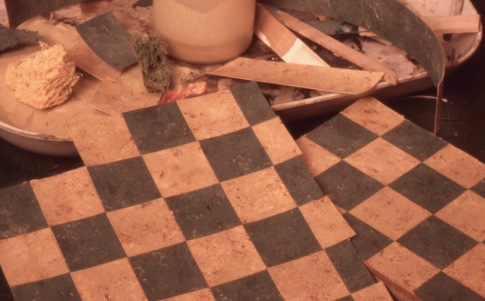
The floor is sponge-painted craft paper cut into squares with an Exacto knife and T-square, and glued down individually, which I can tell you took some sweat and tears to align–but the results are so great! For painting details, see my posting on the Airplane Cafe.
The aged, non-removable couch/fold-out bed cushions I made following upholstery directions from Judee Williamson and Nicole Walton-Marble. My edges are a bit wobbly, but it works from a distance–once installed, it contributes to the look of the whole, without attracting attention to itself. It’s all about illusion, right?
Taking the trailer where it wanted to go–The Guild School in Maine twice, and Nantucket–required a lot of steps, a lot of fitting and fiddling, and I continue to be amazed at how many students wanted to ride along with us. The prototype sits in our dining room, on top of an old oak ice box, the one minature of ours we have on display. As we consider down-sizing, we are also considering selling it. We’re in a negotiating mood–should you be interested, please email me at pst592@outlook.com.



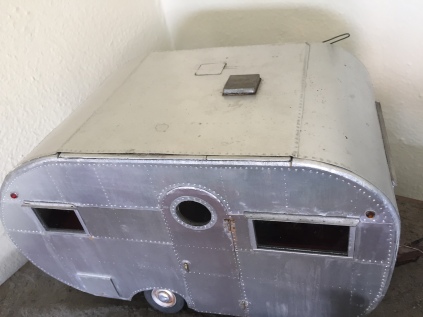






Thanks for sending out tidbits from the past periodically. It is always enjoyable to read. Sue Herber > WordPress.com > smallhousepress posted: ” Ever the car nut, and ever the headline > writer, Noel came up with the line, “You can go where you want with > it,” while conjuring the travel traveler. It would be, of all the > buildings we made, his pet project. Where he really wanted it to go > was downhil” >
Hi Sue–thanks, glad to know you’re enjoying these posts.
I can’t tell you how long I’ve been a fan. Probably from your first project. So happy to find you are still out there.
Thanks, Linda–yes, we’re still out here!
Hi! I decided to look you up to see if you were still around. My name is Kelly Henthorne. My mother- in- law bought Vix Scalemaster from vic’s widow Gail. She had us rename Vix Scalemaster. We came up with Classic Miniatures successor to Vix Scalemaster. We still have the business and are compiling an online catalog. When we bought the business we created a price list for ower customers. Still have them if you want one. Everthing is still the same with a small price hike since pewter prices fluctuate with the stock market. Looking forward to hear from you even if you don’t want a price list.
Hi Kelly, glad to hear from you and that Vic’s things are still out there, his work was so good. Thanks for the offer of the list, but we retired a few years ago and are out of miniatures. Good luck with the business!